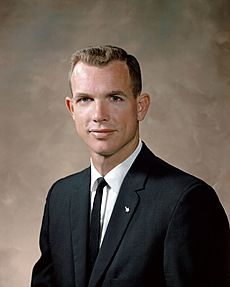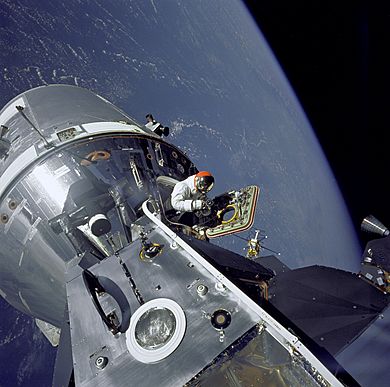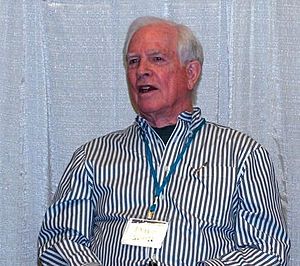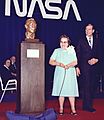David Scott facts for kids
Quick facts for kids
David Scott
|
|
|---|---|
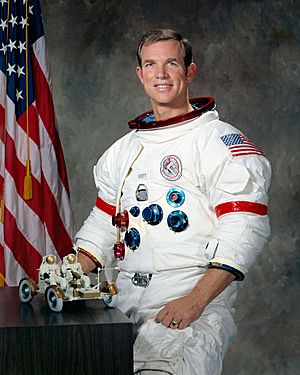
Scott in 1971
|
|
| Born |
David Randolph Scott
June 6, 1932 San Antonio, Texas, U.S.
|
| Awards |
|
| Space career | |
| NASA astronaut | |
| Rank | Brigadier General, USAF |
|
Time in space
|
22d 18h 54m |
| Selection | NASA Group 3 (1963) |
|
Total EVAs
|
5 Stand-up EVA on Apollo 9 4 EVAs on Apollo 15 (1st EVA was a stand-up, while 3 EVAs were on the lunar surface) |
|
Total EVA time
|
20h 46m |
| Missions | |
|
Mission insignia
|
   |
| Retirement | September 30, 1977 |
David Randolph Scott (born June 6, 1932) is a retired American test pilot and NASA astronaut. He was the seventh person to walk on the Moon. In 1963, Scott was chosen to be in the third group of astronauts for NASA. He flew to space three times and was the commander of Apollo 15, the fourth mission to land on the Moon. He is one of only four living Moon walkers.
Before he became an astronaut, Scott graduated from the United States Military Academy at West Point and joined the Air Force. He was a fighter pilot in Europe and later graduated from the Air Force Experimental Test Pilot School. Scott retired from the Air Force in 1975 with over 5,600 hours of flying time.
As an astronaut, Scott's first space mission was Gemini 8 in March 1966 with Neil Armstrong. He then flew on Apollo 9 in March 1969, where he tested the Apollo spacecraft. His final flight was as commander of Apollo 15 in 1971, where he and James Irwin spent three days on the Moon.
After his space flights, Scott and his crewmates got into trouble with NASA. It was discovered they had carried postal covers (stamped envelopes) to the Moon without permission. After this, Scott became the director of NASA's Dryden Flight Research Center in California. He retired from NASA in 1977. Since then, he has worked on space-related projects and was a consultant for movies like Apollo 13.
Contents
Early Life and Education
David Scott was born on June 6, 1932, at Randolph Field near San Antonio, Texas. His father, Tom William Scott, was a fighter pilot in the United States Army Air Corps who became a brigadier general. Because of his father's job, his family moved often, even living in the Philippines.
Scott was determined to become a pilot like his father. He built many model airplanes and loved watching war movies about flying. He was active in the Boy Scouts of America and became a Life Scout. He was also a talented swimmer in high school, setting several records in California.
Scott wanted to attend the United States Military Academy at West Point. After first attending the University of Michigan on a swimming scholarship, he received an invitation to West Point and accepted it. He wanted to join the newly formed United States Air Force (USAF). In 1954, he graduated 5th in his class of 633 and was commissioned as an officer in the Air Force.
Career as an Air Force Pilot
Scott began his pilot training in 1954. From 1956 to 1960, he was stationed at Soesterberg Air Base in the Netherlands, where he flew F-86 and F-100 fighter jets. The weather was often bad, which tested his flying skills. Once, he even had to land his plane on a golf course after the engine failed.
To advance his career, Scott wanted to become a test pilot. He earned two advanced degrees in Aeronautics and Astronautics from the Massachusetts Institute of Technology (MIT) in 1962. After graduating, he was accepted into the Air Force Experimental Flight Test Pilot School at Edwards Air Force Base. There, he learned to fly experimental aircraft at very high altitudes and graduated as the top pilot in his class.
NASA Career
In 1963, Scott applied to be an astronaut, thinking it would be a temporary part of his military career. He was accepted into the third group of astronauts. His first job was to work with MIT on the development of the Apollo Guidance Computer.
Gemini 8
Scott's first spaceflight was Gemini 8 in March 1966, with Neil Armstrong as the commander. This made Scott the first astronaut from his group to be assigned to a prime crew. His job was to pilot the mission.
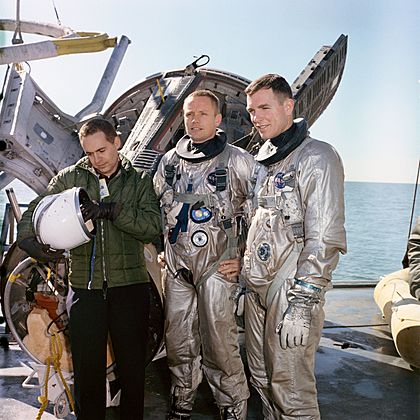
On March 16, 1966, Armstrong and Scott launched into space. Their main goal was to dock with an unmanned Agena rocket, which they did successfully. This was the first-ever docking in space. However, soon after docking, their spacecraft began to spin out of control.
The problem was a stuck thruster on their Gemini capsule. To stop the dangerous spin, Armstrong had to use the thrusters meant for re-entry. Mission rules required them to return to Earth immediately if these thrusters were used early. The mission was cut short, lasting only 11 hours instead of three days. This meant Scott's planned spacewalk had to be canceled.
Apollo 9
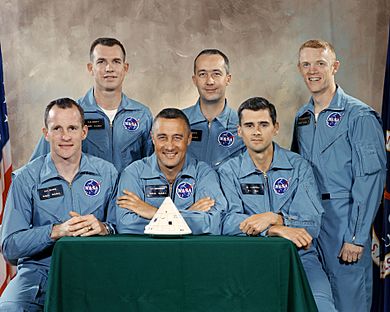
After Gemini 8, Scott was assigned to the Apollo program. He was part of the backup crew for Apollo 1. After a tragic fire killed the Apollo 1 crew during a test, Scott helped design a new, safer hatch for the spacecraft.
His crew was then assigned to Apollo 9. This mission was designed to be the first flight test of the complete Apollo spacecraft, including the Lunar Module (LM), in Earth's orbit. Scott was the Command Module Pilot.
The mission launched on March 3, 1969. Scott piloted the Command Module, named Gumdrop, and docked with the Lunar Module, named Spider. Later in the mission, the two spacecraft separated. Scott remained alone in Gumdrop while his crewmates, Jim McDivitt and Rusty Schweickart, flew Spider over 100 miles away before returning to dock again. This was a critical test to prove the LM could fly independently and return safely. The mission was a success and splashed down in the Atlantic Ocean on March 13, 1969.
Apollo 15

Scott's excellent performance on Apollo 9 led to his next assignment as backup commander for Apollo 12. This put him in line to command Apollo 15. This mission was the first "J Mission," which focused on science and included a longer stay on the Moon and the use of the Lunar Roving Vehicle (LRV).

Apollo 15 launched on July 26, 1971. On July 30, Scott and fellow astronaut James Irwin landed the Lunar Module Falcon near a channel on the Moon called Hadley Rille. Scott was the seventh person to walk on the Moon.
After landing, Scott performed a "stand-up" spacewalk, poking his head out of the top of the LM to survey the area. He and Irwin then deployed the LRV, the first car driven on the Moon. They drove it across the lunar surface to collect rock samples and conduct experiments. One famous rock they found was the Genesis Rock, an ancient piece of the Moon's crust.
On their final moonwalk, Scott famously demonstrated Galileo's theory that objects in a vacuum fall at the same rate. He dropped a hammer and a feather, and they hit the ground at the same time. Before leaving, he placed a memorial plaque and a small sculpture called Fallen Astronaut to honor the astronauts and cosmonauts who had died.
Postal Covers Incident
The Apollo 15 crew had made a private deal to carry about 400 unauthorized postal covers (stamped envelopes) to the Moon. They planned to sell them after the mission. This was against NASA rules, and the crew did not get official permission.
When NASA found out, Scott, Worden, and Irwin were removed as the backup crew for Apollo 17. The incident became public, and the astronauts were reprimanded for their poor judgment. This meant they would likely never fly in space again.
NASA Management
After the incident, Scott became a special assistant for the Apollo-Soyuz Test Project, a joint mission with the Soviet Union. In 1975, he became the director of NASA's Dryden Flight Research Center at Edwards Air Force Base. To take this civilian job, he retired from the Air Force as a colonel. He retired from NASA in 1977.
Life After NASA
After leaving NASA, Scott started his own technology company. He worked as a consultant for several projects, including the movie Apollo 13 and the HBO miniseries From the Earth to the Moon.
In 2006, he co-wrote a book with Russian cosmonaut Alexei Leonov called Two Sides of the Moon: Our Story of the Cold War Space Race. He has continued to be involved in space exploration research.
Personal Life and Awards
Scott married Ann Lurton Ott in 1959, and they had two children. He later married Margaret Black. They live in Los Angeles.
Throughout his career, Scott received many awards, including the NASA Distinguished Service Medal three times and the Distinguished Flying Cross. He was inducted into the International Space Hall of Fame and the U.S. Astronaut Hall of Fame. In 2024, he received an honorary promotion to brigadier general for his service.
Images for kids
-
The Chevrolet Corvettes owned by Scott (right) and Worden during the training for Apollo 15, photographed in 2019.
See also
 In Spanish: David Scott para niños
In Spanish: David Scott para niños


